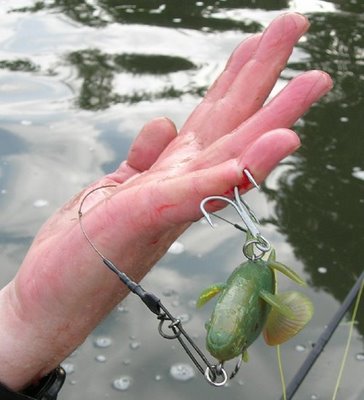 |
 |
 |
| HOME | CONTENTS | JOIN HERE | |||||
| ABOUT
PAC | |||||||
|
Before I get onto the meaty (sic) bit of explaining the best way of removing a barbed hook, I feel it best to mention a few simple other things that can help our health and safety on the bank. First of all, carry a small first aid kit, they’re tiny and can be bought from somewhere like Boots for a few quid. They contain, Plasters, gauze, tape, scissors etc, all stuff to help clean and tidy up a wound. A small bottle of TCP or antiseptic at the bottom of your rucksack will also be of benefit. These little things do go a long way when you’re a long way from home, and/or during a session lasting more than 24 hours. Be sure to clean any cuts thoroughly, preferably in bottled water rather than that which your quarry swims in. Medical studies have shown that simple tap water will clean a wound as well as sterile saline, so don’t be afraid to use it. Fingers and hands bleed like stink, pike bites appear to exacerbate the haemorrhaging (but I’m not going to enter that debate!), so what to do? Wash, wash, and wash! Using the clean water as stated, dry the wound using your gauze then apply a suitably sized dressing. If the bleeding continues, simply raise the area to rest on your shoulder (obviously not possible if its your leg affected), wounds placed above the heart will stop the claret leaking much quicker. So you’ve got a cut, are you now covered for tetanus? More than likely you are, but its best to make sure. Lifelong immunity is usually attained after 5 tetanus boosters, and since 3 are given during childhood, a further 2 will be needed. These are needed at 10 year intervals, which generally means in your mid-twenties and then mid-thirties. If in doubt, contact your GP who should have your records, a booster needs to be given within 48 hours of getting the wound. A quick mention of Weil’s Disease, this is transmitted via rat urine, so please be careful not to leave food and drink exposed for our furry friends to paw over, particularly when bivvied up at night. Weil’s disease is potentially fatal, so its also worth boiling some freshwater in pots/Pans etc prior to use. Hook removal. Never a nice thing, I suppose the easiest way out of this is to use barbless hooks, but if you’re like me then you may have to endure a hook that’s well and truly stuck whilst using the barbed variety. The best method is not to just pull the hook against the barb, but to push the hook and barb through the skin (see diagram 3). If you have the stomach and pain threshold for this then use your forceps, its much easier. Once the hook and barb are exposed then boltcut them off (below the barb see diagram 4), a simple trick here is to place something soft like the sleeve of a top over the exposed hook before bolt-cutting the hook, this prevents the hook point flying off in your eye! Once the barb is off, it’s a simple matter of pulling the rest of the hook out, back through the way it went in. Don’t forget to clean and dress the wound as already stated. Be careful with large deep penetrated hooks, particularly in the areas of the wrist, there are a lot of tendons, nerves, blood vessels that can cause further problems if not dealt with correctly. If in doubt, get to your local A&E. Dr Russell Newlove BSc MBChB |
| HOME | CONTENTS | JOIN HERE | |||||
| ABOUT
PAC | |||||||
 Now
for the boring stuff! Quite frankly these are the sort of articles I usually skip
through when reading fishing related literature, but how many of you have got
a cut when fishing, or a hook embedded somewhere nasty? I know I have.
Now
for the boring stuff! Quite frankly these are the sort of articles I usually skip
through when reading fishing related literature, but how many of you have got
a cut when fishing, or a hook embedded somewhere nasty? I know I have.